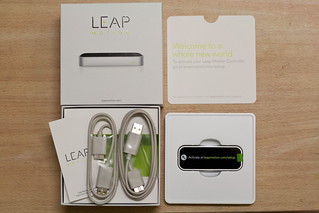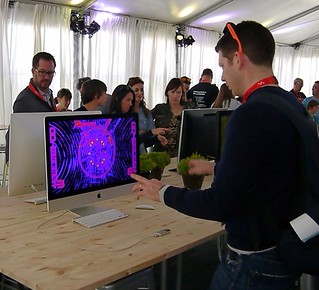I had the chance to trial a Leap Motion the other day, and jumped at the chance. The post below is a brief overview of my experiences.
Leap motion is a gesture peripheral, which uses infrared sensors to track the movement of a user’s hands in (approximately) 30 cm of space above the device.
Getting started
It was a simple process to get started with Leap motion, which basically involved taking the gizmo out of the box, plugging in the USB cable, and downloading and installing software. It all took about 8 or so minutes in total. After downloading the software and installing it, a tutorial demonstrates some of the device’s capability.
Exploring the free Apps
There are a few free apps in the Airspace App Store (named a bit confusingly for Mac users?) to explore including a couple of games, less interactive (but highly visual) illustrations, and way more interactive ‘education’ focussed tasks; the ones I trialled at length were Molecules and Cyber Science 3D Motion.
Benefits
I found all of the apps really visual, and pretty easy to get my head around the motions required to manipulate objects. I could see how, for example, with the human skull, it could help some learners get their heads around not only the names of the bones, but where they are located.
Drawbacks and limitations
At the moment, the Leap motion sensor appears to miss hand movements sometimes, which can be highly frustrating (especially when you are shaping up to get a mega score in Cut the Rope by feeding candy to the monster!). Also, where fine movements are required when, for example, you are lining up a bone to place on the skull, the sensor doesn’t seem to always pick up on the finer movements, and when you make larger movements the bone shoots way out of range.
The Leap also needs to be stationary and the user needs to be situated away from very bright light sources. The light and the extraneous motion cause the sensor to lose track of the user’s hands.
There is also a bit of an issue with arm-fatigue. After a while, my arms started to ache, and I’m pretty sure that this didn’t help with the finesse of my motions!
Overall impression
The Leap motion potentially extends the way, as learners, we can interact with virtual worlds. The fact that focus can be on accuracy and visual experience could be a great way of learning procedures, as well as processes, and how things interact or are structured. I can see how, for instance, a student learning to perform minor surgery could experience how to hold the scalpel, and see what would be visible underneath the skin once an incision is made (although obviously wouldn’t have a sense of pressure).
On the other hand, the ‘lack of accuracy’ in sensing fine motions certainly undermined my experience, making for frustration and resulting in me reaching for the touch pad on my laptop. In part, this is likely my inexperience with working in this type of environment, but this would be true of most people trialling this gizmo.
Potentially, this could be huge, but some of the glitches need to be ironed out before widescale adoption is recommended.
More in depth reviews are available here: http://gizmodo.com/tag/leap-motion
Images
- Trying out the Leap Motion - cc licensed ( BY NC ) flickr photo by Richard: http://flickr.com/photos/rbanks/8566276838/
- Leap Motion in the box - cc licensed ( BY NC SA ) flickr photo by rafm0913: http://flickr.com/photos/rafm0913/9370772677/








No comments:
Post a Comment